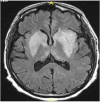Deadly Neuroinvasive Mosquito-Borne Virus: A Case of Eastern Equine Encephalitis
- PMID: 33970094
- PMCID: PMC8784058
- DOI: 10.7812/TPP/20.288
Deadly Neuroinvasive Mosquito-Borne Virus: A Case of Eastern Equine Encephalitis
Abstract
Eastern equine encephalitis (EEE) is a rare and potentially fatal neuroinvasive disease with a high mortality rate of > 30%. It is an uncommon vector-borne illness, with an average of 8 cases reported in the United States annually. Alarmingly, in 2019 alone, the Centers for Disease Control and Prevention (CDC) confirmed 38 cases of EEE virus in the United States, reported from 10 states. In this report, we describe a 42-year-old man who worked primarily in wooded areas and presented to a hospital in southern New Jersey with an intractable headache and global facial paraesthesia. He reported multiple tick bites in the weeks prior to his presentation. Based on high clinical suspicion, cerebrospinal samples were sent to the CDC, which confirmed the diagnosis of EEE. The patient was treated with supportive care, and, after spending 9 days on mechanical ventilation in the intensive care unit, he was extubated and subsequently had some improvement of his symptoms with the implementation of an extensive physical therapy program. We hope this report will contribute to increasing awareness among the public health and medical communities regarding the increasing number of EEE cases and the importance of following prevention measures, especially in areas with high prevalence and early recognition of the disease for treatment.
Copyright © 2021 The Permanente Press. All rights reserved.
Conflict of interest statement
Figures
Similar articles
-
Case report: Eastern equine encephalitis virus imported to the UK.J Med Virol. 2009 Feb;81(2):305-8. doi: 10.1002/jmv.21379. J Med Virol. 2009. PMID: 19107960
-
The clinical and radiographic features of eastern equine encephalitis: A single-center retrospective case series.Medicine (Baltimore). 2024 Dec 27;103(52):e41170. doi: 10.1097/MD.0000000000041170. Medicine (Baltimore). 2024. PMID: 39969305 Free PMC article.
-
Eastern Equine Encephalitis Virus in the United States, 2003-2016.Am J Trop Med Hyg. 2018 May;98(5):1472-1477. doi: 10.4269/ajtmh.17-0927. Epub 2018 Mar 15. Am J Trop Med Hyg. 2018. PMID: 29557336 Free PMC article.
-
Virology, ecology, epidemiology, pathology, and treatment of eastern equine encephalitis.J Neurol Sci. 2024 Feb 15;457:122886. doi: 10.1016/j.jns.2024.122886. Epub 2024 Jan 13. J Neurol Sci. 2024. PMID: 38278094 Review.
-
Five Emerging Neuroinvasive Arboviral Diseases: Cache Valley, Eastern Equine Encephalitis, Jamestown Canyon, Powassan, and Usutu.Semin Neurol. 2019 Aug;39(4):419-427. doi: 10.1055/s-0039-1687839. Epub 2019 Sep 18. Semin Neurol. 2019. PMID: 31533182 Review.
Cited by
-
Efficacy of a brain-penetrant antiviral in lethal Venezuelan and eastern equine encephalitis mouse models.Sci Transl Med. 2023 Apr 12;15(691):eabl9344. doi: 10.1126/scitranslmed.abl9344. Epub 2023 Apr 12. Sci Transl Med. 2023. PMID: 37043558 Free PMC article.
-
Piperazinobenzodiazepinones: New Encephalitic Alphavirus Inhibitors via Ring Expansion of 2-Dichloromethylquinazolinones.ACS Med Chem Lett. 2022 Mar 14;13(4):546-553. doi: 10.1021/acsmedchemlett.1c00539. eCollection 2022 Apr 14. ACS Med Chem Lett. 2022. PMID: 35450382 Free PMC article.
-
Inactivation of Venezuelan Equine Encephalitis Virus Genome Using Two Methods.Viruses. 2022 Jan 28;14(2):272. doi: 10.3390/v14020272. Viruses. 2022. PMID: 35215864 Free PMC article.
-
Advances in the Development of Small Molecule Antivirals against Equine Encephalitic Viruses.Viruses. 2023 Feb 1;15(2):413. doi: 10.3390/v15020413. Viruses. 2023. PMID: 36851628 Free PMC article. Review.
References
Publication types
MeSH terms
LinkOut - more resources
Full Text Sources
Medical


